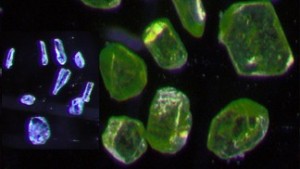Mar 10 2014
Scientists at EPFL have developed a new superconductor which shows a zero-resistance state below 45 K (-228.15oC).
 © 2014 EPFL
© 2014 EPFL
Superconductivity is a phenomenon where electrical current can move through a material with zero resistance when the material is cooled close to absolute zero. Because of its enormous technological potential, there has been increasing effort to develop superconductors that work at higher temperatures. New materials and ways of synthesizing them are explored worldwide to understand the mechanism of high temperature superconductivity. Publishing in Physical Review B, scientists at EPFL have developed a material produced under extreme conditions (30,000 atmospheric pressure, and 1500oC), which can help to answer important questions.
When cooled down to temperatures approximating absolute zero (0 K; -273.15oC), certain materials can ‘superconduct’, i.e. conduct electricity without resistance, meaning that none of it is lost as heat. If implemented, superconductivity could revolutionize the way we use and distribute energy. However, the extremely low temperatures at which materials can superconduct – called critical temperatures – are difficult to implement practically, which has spurred an intense pursuit for high-temperature superconductors (HTS).
Since 2006, much interest in superconductivity has been focused on a group of materials known as oxypnictides. These are materials that contain oxygen, a pnictogen (usually phosphorus and arsenic) and one or more other elements e.g. iron and a lanthanide. But more importantly, oxypnictides have been shown to superconduct at temperatures up to 28K (-245.15oC).
Now, researchers from EPFL’s Laboratory of Physics of Complex Matter have developed a oxypnictide with a new structure type that has a critical temperature close to 45K (-228.15oC). Building on previous work the lead author Sergiy Katrych (teamed with Janusz Karpinski, Andrea Pisoni) grew single crystals of layered superconducting oxypnictides using a cubic anvil; a technique that involves subjecting a chemical precursor to very high pressures in order to achieve crystallization.
The new superconducting oxypnictides have the general formula L4Fe2As2Te1−xO4, where L can be a lanthanide like praseodymium (Pr), samarium (Sm) or gadolinium (Gd). However, the exact molecular structure of the new oxypnictides remained unknown. Given that the capacity of a material to superconduct is almost entirely dependent on its three-dimensional architecture, the lack of information limited further exploration of a very promising HTS material.
To shed light on the mystery, the authors performed a systematic study of the oxypnictide’s structure and physical properties. The data showed that the structure of the new superconductors contained similar structural blocks as a known oxypnictide superconductor. In addition, the analysis revealed the critical temperature of each material was around 25 K and did not appear to depend on type of lanthanide used.
Nonetheless, the researchers found that introducing fluorine into the samarium and gadolinium oxypnictides (a process known as ‘doping’) increased their critical temperatures up to 40 K and 45 K respectively. This finding represents an important step in designing superconductors with even higher transition temperatures. The authors now aim to determine the maximum critical temperature of their novel material, which will involve more detailed studies of its dependence on doping.